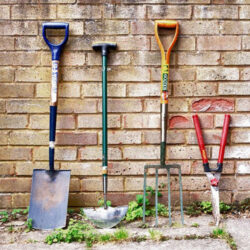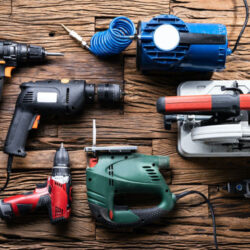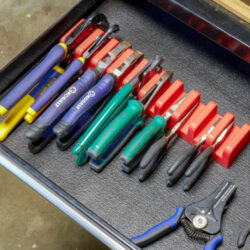Power & Hand Tools
Cordlesspowertools Canada Online stores have a wide range of Power & Hand Tools Products that are available in different types and prices. Popular brands like Bosch, Dewalt, Hitachi, Dongcheng, Cumi, KPT, Ferm, Black Decker, Makita, Jon Bhandari, Ken, Metabo, Bullet, Planet Power, Stanley, Maktec, Ralli Wolf, AOG, Falcon, Hit-Min, IDeal, Eastman, Fein, Electrex, Craftsman, AEG, Zogo, Xtra Power, DCA, Yuri have a vast range of models available with different designs and functionalities. You can easily browse through the products, compare them and choose the one that best fits your needs.
-

Gardening Tools (1)
-

Hand Tools (1)
-

Power Tool Parts & Accessories (1)
-

Power Tools (1)
-

Tool Organizers (1)
Power & Hand Tools: Essential Tools for Every Task
When it comes to completing projects efficiently, having the right power & hand tools is crucial. From assembling furniture to tackling DIY home repairs, tools such as socket sets, screwdrivers, and electric saws ensure precision and ease of work. Whether you're a professional or a DIY enthusiast, investing in high-quality power tools like cordless screwdrivers or circular power saws can significantly enhance your productivity. In this guide, we'll explore essential tools, their features, and how they make your tasks simpler.
Why Power & Hand Tools Are Essential
Whether it's a small home improvement task or a larger renovation project, power & hand tools are indispensable. Having a set of reliable socket sets and screwdrivers allows you to handle tightening, loosening, and adjusting parts with ease. For more intensive tasks, electric saws and cordless screwdrivers save time and effort, offering accuracy and speed. Moreover, gardening tools are crucial for maintaining outdoor spaces, ensuring tasks like pruning and planting are handled efficiently.
Top Tools to Have in Your Toolkit
- Socket Sets
A complete set of socket sets ensures you have the right tool to fit any bolt or nut. These tools are vital for automotive repairs, machinery adjustments, and various other tasks that require precise fastening. - Screwdrivers
Whether it's a manual screwdriver or an electric screwdriver, these are basic yet essential tools for any job. With different head sizes, screwdrivers help with assembling and fixing a wide variety of items around the house or workspace. - Circular Power Saw
For cutting wood, metal, or plastic with precision, an electric circular power saw is the go-to tool. It’s a powerful tool used in carpentry, construction, and even DIY projects to make accurate cuts in various materials. - Cordless Screwdriver
When speed and mobility are essential, a cordless screwdriver is a must-have. It eliminates the hassle of cords, making it convenient to use anywhere. Its rechargeable battery ensures it’s always ready for quick repairs or installations. - Electric Saw
An electric saw is an advanced tool for cutting various materials effortlessly. Its power and accuracy make it ideal for larger projects like furniture building or home renovations. - Gardening Tools
Maintaining your garden becomes much easier with the right gardening tools. From pruning shears to hoes, these tools help with planting, trimming, and maintaining the aesthetic of your outdoor spaces.
Key Features to Look For
- Durability: Always opt for tools made from high-quality materials like stainless steel or carbon steel to ensure long-lasting use.
- Comfort Grip: Tools like screwdrivers and socket sets should have an ergonomic design to ensure a comfortable grip, making them easier to use for extended periods.
- Portability: Tools like cordless screwdrivers and electric saws should be lightweight and easy to carry around for convenience on-site or at home.
- Power Efficiency: For electric tools like electric screwdrivers and saws, power efficiency ensures better performance and longer battery life for cordless models.
- Precision: Tools like socket sets and saws must offer precision to ensure accurate adjustments and cuts for a professional finish.
Transition to Enhanced Productivity
Transitioning from basic tools to high-quality power & hand tools can significantly improve the quality and speed of your work. Tools like electric saws and cordless screwdrivers not only enhance efficiency but also offer the flexibility to work on various tasks without restrictions.
Conclusion
Investing in the right energy & hand tools is key to successfully completing any project. Whether you're a professional craftsman or a DIY enthusiast, tools like socket sets, screwdrivers, circular saws, and gardening tools are indispensable in achieving accurate and efficient results. Look for durable, portable, and energy-efficient tools that match your needs to ensure long-lasting and high-performance use.
Power & Hand Tools: Essential Tools for Every Task
When it comes to completing projects efficiently, having the right power & hand tools is crucial. From assembling furniture to tackling DIY home repairs, tools such as socket sets, screwdrivers, and electric saws ensure precision and ease of work. Whether you're a professional or a DIY enthusiast, investing in high-quality power tools like cordless screwdrivers or circular power saws can significantly enhance your productivity. In this guide, we'll explore essential tools, their features, and how they make your tasks simpler.
Why Power & Hand Tools Are Essential
Whether it's a small home improvement task or a larger renovation project, power & hand tools are indispensable. Having a set of reliable socket sets and screwdrivers allows you to handle tightening, loosening, and adjusting parts with ease. For more intensive tasks, electric saws and cordless screwdrivers save time and effort, offering accuracy and speed. Moreover, gardening tools are crucial for maintaining outdoor spaces, ensuring tasks like pruning and planting are handled efficiently.
Top Tools to Have in Your Toolkit
- Socket Sets
A complete set of socket sets ensures you have the right tool to fit any bolt or nut. These tools are vital for automotive repairs, machinery adjustments, and various other tasks that require precise fastening. - Screwdrivers
Whether it's a manual screwdriver or an electric screwdriver, these are basic yet essential tools for any job. With different head sizes, screwdrivers help with assembling and fixing a wide variety of items around the house or workspace. - Circular Power Saw
For cutting wood, metal, or plastic with precision, an electric circular power saw is the go-to tool. It’s a powerful tool used in carpentry, construction, and even DIY projects to make accurate cuts in various materials. - Cordless Screwdriver
When speed and mobility are essential, a cordless screwdriver is a must-have. It eliminates the hassle of cords, making it convenient to use anywhere. Its rechargeable battery ensures it’s always ready for quick repairs or installations. - Electric Saw
An electric saw is an advanced tool for cutting various materials effortlessly. Its power and accuracy make it ideal for larger projects like furniture building or home renovations. - Gardening Tools
Maintaining your garden becomes much easier with the right gardening tools. From pruning shears to hoes, these tools help with planting, trimming, and maintaining the aesthetic of your outdoor spaces.
Key Features to Look For
- Durability: Always opt for tools made from high-quality materials like stainless steel or carbon steel to ensure long-lasting use.
- Comfort Grip: Tools like screwdrivers and socket sets should have an ergonomic design to ensure a comfortable grip, making them easier to use for extended periods.
- Portability: Tools like cordless screwdrivers and electric saws should be lightweight and easy to carry around for convenience on-site or at home.
- Power Efficiency: For electric tools like electric screwdrivers and saws, power efficiency ensures better performance and longer battery life for cordless models.
- Precision: Tools like socket sets and saws must offer precision to ensure accurate adjustments and cuts for a professional finish.
Transition to Enhanced Productivity
Transitioning from basic tools to high-quality power & hand tools can significantly improve the quality and speed of your work. Tools like electric saws and cordless screwdrivers not only enhance efficiency but also offer the flexibility to work on various tasks without restrictions.
Conclusion
Investing in the right energy and hand tools is key to successfully completing any project. Moreover, whether you're a professional craftsman or a DIY enthusiast, tools like socket sets, screwdrivers, circular saws, and gardening tools are indispensable in achieving accurate and efficient results. Therefore, it is crucial to look for durable, portable, and energy-efficient tools that match your needs. By doing so, you can ensure long-lasting and high-performance use. Additionally, such tools not only enhance productivity but also contribute to the quality of your work.
Power & Hand Tools: Essential Tools for Every Task
When it comes to completing projects efficiently, having the right power & hand tools is crucial. From assembling furniture to tackling DIY home repairs, tools such as socket sets, screwdrivers, and electric saws ensure precision and ease of work. Whether you're a professional or a DIY enthusiast, investing in high-quality power tools like cordless screwdrivers or circular power saws can significantly enhance your productivity. In this guide, we'll explore essential tools, their features, and how they make your tasks simpler.
Why Power & Hand Tools Are Essential
Whether it's a small home improvement task or a larger renovation project, power & hand tools are indispensable. Having a set of reliable socket sets and screwdrivers allows you to handle tightening, loosening, and adjusting parts with ease. For more intensive tasks, electric saws and cordless screwdrivers save time and effort, offering accuracy and speed. Moreover, gardening tools are crucial for maintaining outdoor spaces, ensuring tasks like pruning and planting are handled efficiently.
Top Tools to Have in Your Toolkit
- Socket Sets
A complete set of socket sets ensures you have the right tool to fit any bolt or nut. These tools are vital for automotive repairs, machinery adjustments, and various other tasks that require precise fastening. - Screwdrivers
Whether it's a manual screwdriver or an electric screwdriver, these are basic yet essential tools for any job. With different head sizes, screwdrivers help with assembling and fixing a wide variety of items around the house or workspace. - Circular Power Saw
For cutting wood, metal, or plastic with precision, an electric circular power saw is the go-to tool. It’s a powerful tool used in carpentry, construction, and even DIY projects to make accurate cuts in various materials. - Cordless Screwdriver
When speed and mobility are essential, a cordless screwdriver is a must-have. It eliminates the hassle of cords, making it convenient to use anywhere. Its rechargeable battery ensures it’s always ready for quick repairs or installations. - Electric Saw
An electric saw is an advanced tool for cutting various materials effortlessly. Its power and accuracy make it ideal for larger projects like furniture building or home renovations. - Gardening Tools
Maintaining your garden becomes much easier with the right gardening tools. From pruning shears to hoes, these tools help with planting, trimming, and maintaining the aesthetic of your outdoor spaces.
Key Features to Look For
- Durability: Always opt for tools made from high-quality materials like stainless steel or carbon steel to ensure long-lasting use.
- Comfort Grip: Tools like screwdrivers and socket sets should have an ergonomic design to ensure a comfortable grip, making them easier to use for extended periods.
- Portability: Tools like cordless screwdrivers and electric saws should be lightweight and easy to carry around for convenience on-site or at home.
- Power Efficiency: For electric tools like electric screwdrivers and saws, power efficiency ensures better performance and longer battery life for cordless models.
- Precision: Tools like socket sets and saws must offer precision to ensure accurate adjustments and cuts for a professional finish.
Transition to Enhanced Productivity
Transitioning from basic tools to high-quality power & hand tools can significantly improve the quality and speed of your work. Tools like electric saws and cordless screwdrivers not only enhance efficiency but also offer the flexibility to work on various tasks without restrictions.
Conclusion
Investing in the right energy & hand tools is key to successfully completing any project. Whether you're a professional craftsman or a DIY enthusiast, tools like socket sets, screwdrivers, circular saws, and gardening tools are indispensable in achieving accurate and efficient results. Look for durable, portable, and energy-efficient tools that match your needs to ensure long-lasting and high-performance use.
Power & Hand Tools: Essential Tools for Every Task
When it comes to completing projects efficiently, having the right power & hand tools is crucial. From assembling furniture to tackling DIY home repairs, tools such as socket sets, screwdrivers, and electric saws ensure precision and ease of work. Whether you're a professional or a DIY enthusiast, investing in high-quality power tools like cordless screwdrivers or circular power saws can significantly enhance your productivity. In this guide, we'll explore essential tools, their features, and how they make your tasks simpler.
Why Power & Hand Tools Are Essential
Whether it's a small home improvement task or a larger renovation project, power & hand tools are indispensable. Having a set of reliable socket sets and screwdrivers allows you to handle tightening, loosening, and adjusting parts with ease. For more intensive tasks, electric saws and cordless screwdrivers save time and effort, offering accuracy and speed. Moreover, gardening tools are crucial for maintaining outdoor spaces, ensuring tasks like pruning and planting are handled efficiently.
Top Tools to Have in Your Toolkit
- Socket Sets
A complete set of socket sets ensures you have the right tool to fit any bolt or nut. These tools are vital for automotive repairs, machinery adjustments, and various other tasks that require precise fastening. - Screwdrivers
Whether it's a manual screwdriver or an electric screwdriver, these are basic yet essential tools for any job. With different head sizes, screwdrivers help with assembling and fixing a wide variety of items around the house or workspace. - Circular Power Saw
For cutting wood, metal, or plastic with precision, an electric circular power saw is the go-to tool. It’s a powerful tool used in carpentry, construction, and even DIY projects to make accurate cuts in various materials. - Cordless Screwdriver
When speed and mobility are essential, a cordless screwdriver is a must-have. It eliminates the hassle of cords, making it convenient to use anywhere. Its rechargeable battery ensures it’s always ready for quick repairs or installations. - Electric Saw
An electric saw is an advanced tool for cutting various materials effortlessly. Its power and accuracy make it ideal for larger projects like furniture building or home renovations. - Gardening Tools
Maintaining your garden becomes much easier with the right gardening tools. From pruning shears to hoes, these tools help with planting, trimming, and maintaining the aesthetic of your outdoor spaces.
Key Features to Look For
- Durability: Always opt for tools made from high-quality materials like stainless steel or carbon steel to ensure long-lasting use.
- Comfort Grip: Tools like screwdrivers and socket sets should have an ergonomic design to ensure a comfortable grip, making them easier to use for extended periods.
- Portability: Tools like cordless screwdrivers and electric saws should be lightweight and easy to carry around for convenience on-site or at home.
- Power Efficiency: For electric tools like electric screwdrivers and saws, power efficiency ensures better performance and longer battery life for cordless models.
- Precision: Tools like socket sets and saws must offer precision to ensure accurate adjustments and cuts for a professional finish.
Transition to Enhanced Productivity
Transitioning from basic tools to high-quality power & hand tools can significantly improve the quality and speed of your work. Tools like electric saws and cordless screwdrivers not only enhance efficiency but also offer the flexibility to work on various tasks without restrictions.
Conclusion
Investing in the right energy and hand tools is key to successfully completing any project. Moreover, whether you're a professional craftsman or a DIY enthusiast, tools like socket sets, screwdrivers, circular saws, and gardening tools are indispensable in achieving accurate and efficient results. Therefore, it is crucial to look for durable, portable, and energy-efficient tools that match your needs. By doing so, you can ensure long-lasting and high-performance use. Additionally, such tools not only enhance productivity but also contribute to the quality of your work.
